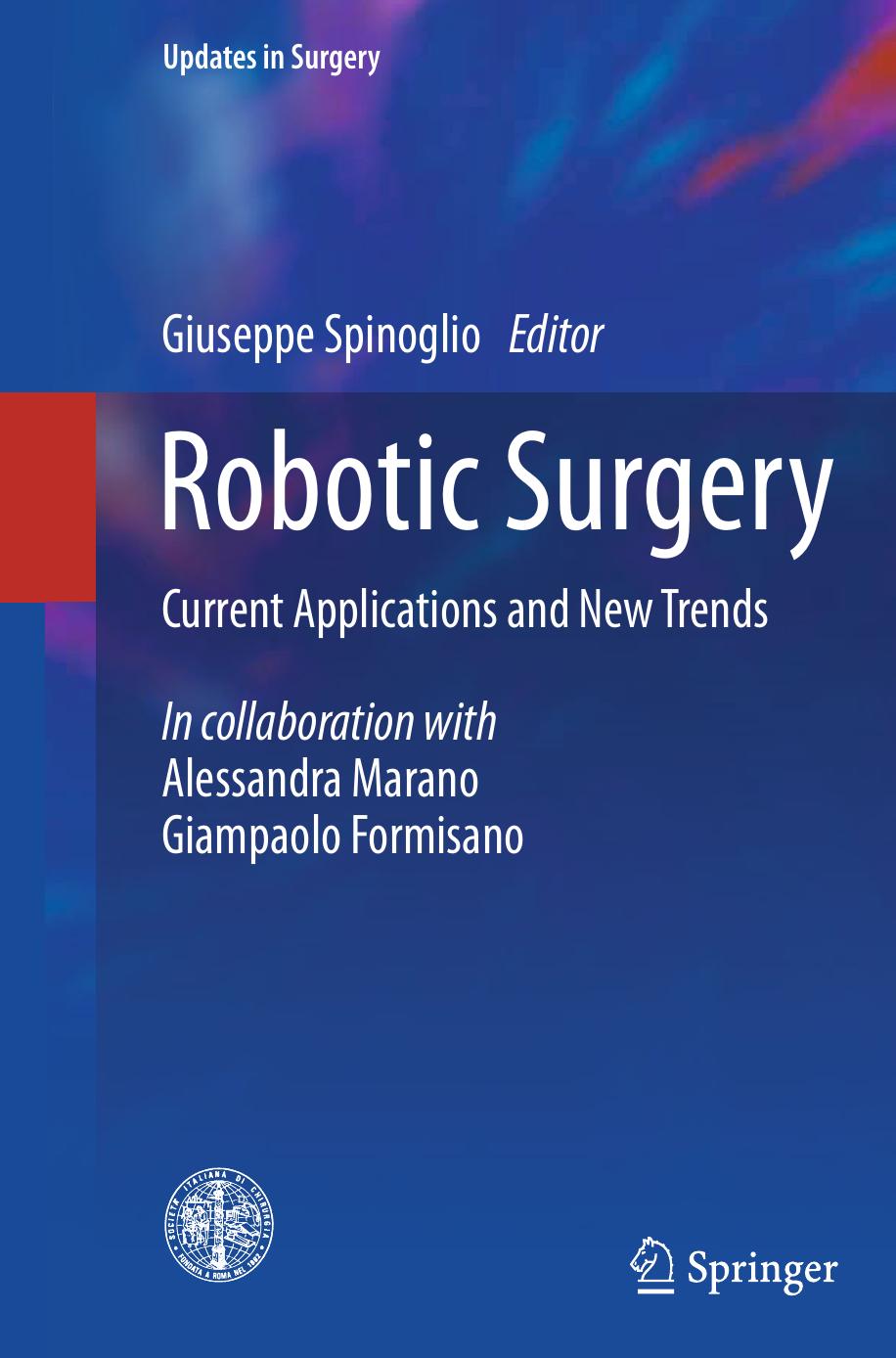Robotic Surgery Current Applications and New Trends 1st edition by Giuseppe Spinoglio 9788847057142, 8847057140
$70.00 Original price was: $70.00.$35.00Current price is: $35.00.
Instant download Robotic Surgery Current Applications and New Trends after payment
Robotic Surgery Current Applications and New Trends 1st edition by Giuseppe Spinoglio – Ebook PDF Instant Download/Delivery: 9788847057142, 8847057140
Full dowload Robotic Surgery Current Applications and New Trends 1st edition after payment

Product details:
• ISBN 10:8847057140
• ISBN 13:9788847057142
• Author:Giuseppe Spinoglio
Robotic Surgery
Current Applications and New Trends
This book describes the current applications of the robotic system in general surgery, focusing on the technical aspects of the procedures most commonly performed by this means. It provides a comprehensive overview of the state of the art in robotic surgery and presents the most recently available evidence as documented in the literature. The opening chapters review robotic platforms, discuss the general advantages, limitations, and strategies of robotic surgery, and identify challenges and critical elements when setting up a robotic program. The full range of applications of the robotic system is then covered, encompassing thoracic, esophageal, gastric, hepatobiliopancreatic, splenic, colorectal, endocrine, and transplantation surgery. Detailed attention is also paid to innovative applications and future trends in the robotic platform, with inclusion of a special chapter on fluorescence imaging during robotic procedures. The book closes by considering aspects related to credentialing and privileging, such as mentoring, proctoring, and teaching modules for residents and fellows. Against the background of increasing acceptance of the robotic surgery system across the globe, this book will be invaluable for all general surgeons. There is no doubt that within general surgery the system will continue to flourish on account of its undoubted technical advantages, which minimize most of the intrinsic shortcomings of laparoscopy.
Robotic Surgery Current Applications and New Trends 1st Table of contents:
1 History of Robotic Surgery
1.1 Introduction
1.2 Da Vinci® Surgical System
1.2.1 Introduction
1.2.2 Da Vinci® System Overview
1.2.3 da Vinci® Xi™ System
1.3 Additional Evolving Technologies
1.3.1 Single-Site™ Platform
1.3.2 FireFly™ Imaging System
1.3.3 New Devices
1.4 Conclusions
References
Part I Neck and Thoracic Surgery
2 Transaxillary Thyroidectomy and Parathyroidectomy
2.1 Procedure Overview
2.2 Patient Positioning
2.3 Robot Positioning
2.4 Procedure
2.4.1 Step 1 (Working Space Time)
2.4.2 Step 2 (Docking Time)
2.4.3 Step 3 (Console Time)
2.5 Indications and Contraindications
2.6 Perioperative and Postoperative Complications
2.7 Personal Experience
2.8 Conclusions
References
3 Zenker Diverticulum Treatment
3.1 Introduction
3.2 Patient Positioning
3.3 Step-by-Step Review of the Surgical Technique
3.4 Literature Evidence
3.5 Personal Experience
3.6 Conclusions
References
4 Thoracic Surgery
4.1 Procedure Overview
4.2 Patient Positioning, Robot Positioning and System Docking
4.3 Step-by-Step Review of Critical Elements of the Procedure
4.3.1 Lobectomy
4.3.2 Segmentectomy
4.3.3 Mediastinal Lymph Node Dissection
4.3.4 Resection of Anterior Mediastinal Lesions
4.3.5 Postoperative Care
4.4 Advantages, Limitations and Relative Contraindications
References
Part II Upper Gastrointestinal Surgery
5 Esophagectomy for Cancer
5.1 Procedure Overview
5.2 Patient Positioning
5.3 Robot Positioning and Docking
5.4 Trocar Placement
5.5 Step-by-Step Review of Critical Elements of the Procedure
5.6 Advantages, Limitations and Relative Contraindications (Personal Experience and Literature Outco
5.7 Results of RAMIE
References
6 Anti-reflux Procedures and Cardioesophagomyotomy
6.1 Anti-reflux Procedures
6.1.1 Introduction
6.1.2 Procedure Overview
6.1.3 Patient Positioning
6.1.4 Robot Positioning and Docking
6.1.5 Trocar Placement
6.1.6 Critical Elements of the Procedure
6.1.7 Advantages of Robot-assisted Laparoscopic Fundoplication
6.2 Cardioesophagomyotomy
6.2.1 Introduction
6.2.2 Patient and Robot Positioning, Trocar Placement and Docking
6.2.3 Critical Elements of the Procedure
6.2.4 Advantages of Robot-assisted Cardioesophagomyotomy
References
7 Gastrectomy for Cancer
7.1 Procedure Overview
7.2 Patient Positioning
7.3 Robot Positioning and Docking
7.4 Trocar Placement
7.5 Step-by-Step Review of Critical Elements of the Procedure
7.5.1 Distal Subtotal Gastrectomy
7.5.1.1 Exploration
7.5.1.2 Coloepiploic Detachment
7.5.1.3 Section of Left Gastroepiploic Vessels
7.5.1.4 Section of Right Gastroepiploic and Gastric Vessels
7.5.1.5 Duodenal Section
7.5.1.6 Section of Left Gastric Vessels and Lymphadenectomy
7.5.1.7 Gastric Transection
7.5.1.8 Reconstruction
7.5.2 Total Gastrectomy
7.5.2.1 Section of Short Gastric Vessels
7.5.2.2 lymphadenectomy
7.5.2.3 Esophageal Transection
7.5.2.4 Reconstruction
7.6 Advantages, Limitations and Outcomes of Robotic Gastrectomy
7.6.1 Technical Aspects
7.6.2 D2-Lymphadenectomy
7.6.3 Oncological Safety
7.6.4 Digestive Restoration
7.6.5 Perioperative Outcomes
7.6.5.1 Hospital Stay
7.6.5.2 Operative Time
7.6.5.3 Blood Loss
7.6.5.4 Complications
7.6.6 Cost Analysis
7.7 Conclusions
References
8 Robotic Subtotal Gastrectomy: a Modified Korean Technique
8.1 Procedure Overview
8.2 Patient and Robot Positioning
8.3 Trocar Placement
8.4 Step-by-Step Review of Critical Elements of the Procedure
8.4.1 Exploration, Liver Retraction and Tumor Detection
8.4.2 Left and Right Gastroepiploic Vessels Division
8.4.3 Hepatoduodenal Ligament Dissection and Duodenal Transection
8.4.4 Lymphadenectomy of the Suprapancreatic Area and Left Gastric Artery Ligation
8.4.5 Lesser Curvature Dissection and Proximal Gastric Resection
8.4.6 Reconstruction
8.5 Advantages
8.6 Personal Experience
References
Part III HepatobiIiopancreatic Surgery
9 Hepatic Resections
9.1 Procedure Overview
9.2 Operating Room Setup, Patient and Trocar Positioning
9.3 Ultrasound Exploration
9.4 Basic Maneuvers of Liver Surgery
9.4.1 The Pringle Maneuver and the Inflow Control
9.4.2 Parenchymal Transection
9.4.3 Liver Retraction
9.5 Step-by-Step Review of Critical Elements of Hemihepatectomies and Bisegmentectomies
9.5.1 Right Hepatectomy
9.5.2 Left Hepatectomy
9.5.3 Left Lateral Sectionectomy
9.6 Step-by-Step Review of Critical Elements of Segmentectomies and Sub-segmentectomies
9.7 Indications and Results of Robot-assistance in Liver Surgery
References
10 Biliary Tract Tumors (Resection and Reconstruction)
10.1 Classification
10.2 Surgical Treatment
Part IV Lower Gastrointestinal Surgery
Part V New Technologies in Robotic Platform
Part VI Miscellany
People also search for Robotic Surgery Current Applications and New Trends 1st:
robotic surgery current
robotic surgery current applications and future directions
robotic surgery a current perspective
current state of robotic surgery
current issues in robotic surgery


